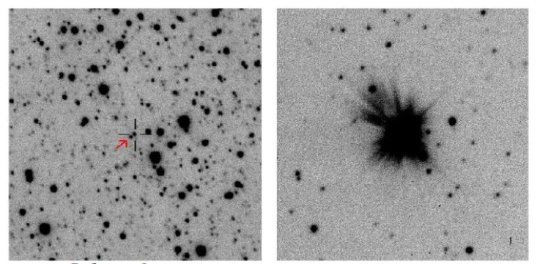Brightest-Ever 'New Star' In Neighboring Small Megellanic Cloud Galaxy Found

Astronomers from the University of Leicester announced Wednesday that they have discovered one of the most luminous "new star" or nova ever recorded.
The nova — which was formed when a dying star erupted back to life — was discovered in one of our neighboring galaxies called the Small Magellanic Cloud (SMC).
Astronomers from the University of Leicester and the South African Astronomical Observatory used the Swift satellite launched by NASA and telescopes from South Africa, Australia and South America to reveal the nova named “SMCN 2016-10a” as the most luminous nova ever observed in the galaxy and one of the most luminous ever recorded.
The X-ray camera on Swift, built by a team from University of Leicester, helped the astronomers discover one of the most luminous white dwarf eruptions ever seen by humans.
A nova occurs when a dying star or a star that is near death, erupts back to life. This happens because in closed binary star systems — where a white dwarf is found in close proximity to a much smaller, sun-like star — material transfer happens between the two stars. This exchange of materials causes a gradual build-up of pressure within the nova star. This causes an effect known as “nuclear burning,” which causes the star to emit large quantities of light.
Information about novae is collected through normal imaging and also X-ray study. This is because though they emit visible light, they also emit very high energy X-ray. The data obtained from both sources contribute to a more complete understanding of a nova's core. Temperature and chemical composition can be judged by using both cameras’ available on Swift.
The team discovered the nova on 14 October 2016. This nova was identified as the most luminous nova discovered in the SMC and also the brightest star observed by humans, in a report that was accepted for publication in the Monthly Notices Of The Royal Astronomical Society. The report was made available for pre-print viewing on 10 October.
The SMC is at a distance of 2,00,00 light years from Earth, making it our closest companion galaxy. As the SMC is very small compared to the Milky Way galaxy, novae sightings are rare. We detect around 35 novae every year in the Milky Way galaxy but SMCN 2016-10a is the first nova spotting in the SMC galaxy since 2012.
"Swift's ability to respond rapidly, together with its daily-planned schedule, makes it ideal for the follow-up of transients, including novae. It was able to observe the nova throughout its eruption, starting to collect very useful X-ray and UV data within a day of the outburst first being reported. The X-ray data were essential in showing that the mass of the white dwarf is close to the theoretical maximum; continued accretion might cause it eventually to be totally destroyed in a supernova explosion," said Dr Kim Page, a member of the Swift team at the University of Leicester, and lead of the X-ray analysis team said in a report by ScienceDaily.
The Swift observations were in the right spectral color. The observations from different telescopes also revealed the nova in various wavelengths, according to Paul Kuin, from the Mullard Space Science Laboratory, University College London, who organized the UV data for the study. The multiple viewing angles show us the composition of the nova ejecta, he added in the report.
It is an interesting find and helps us further understand novae in nearby galaxies. The imaging techniques used form a blueprint for understanding these distant sources of bright light. This intrinsically bright explosion could help us understand the chemical processes involved in the explosion. The team believes that these explosions hold the key to plotting the future of our sun and gauging the effects of a nova explosion in the Milky Way.
© Copyright IBTimes 2024. All rights reserved.





















